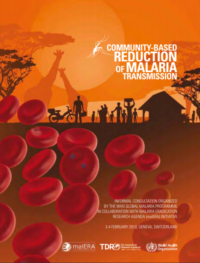Community-based reduction of malaria transmission
Collaborator(s): Malaria Eradication Research Agenda (malERA), Spain; Special Programme for Research and Training in Tropical Diseases (TDR), Switzerland
Published: 01/01/2012
Community-based reduction of malaria transmission: Consultation Report
WHO, the Special Programme for Research and Training in Tropical Diseases (TDR) and the Malaria Eradication Research Agenda initiative outline a comprehensive package of recommended community-based interventions. The report documents the outcome of an expert consultation held in Geneva, Switzerland on 3–4 February 2010.
The approach is based on the conception that equipping communities with the necessary tools to help themselves while simultaneously increasing local demand for malaria control could significantly reduce malaria burden in the remaining – often hard-to-reach – pockets. This approach would complement, rather than replace, existing vector control measures, and would build on the community-based approach to malaria case management, which has proved to be highly effective in a wide range of epidemiological settings. It also has the potential to help governments match resources to the local burden and to actual needs for control efforts.
Eliminating the remaining reservoirs of parasites cannot be achieved without considerable local commitment and capacity strengthening for community health workers. First, these workers will need to be trained to be able to identify – through diagnostic testing – those individuals who carry Plasmodium parasites but do not necessarily develop malaria symptoms. Second, they need to be capable of providing effective treatment to those who have confirmed infections, and later accurately reporting results.
This approach conceptually differs from the standard treatment of malaria cases (providing diagnostic testing only to those with symptoms of malaria) – which does not fully address the issue of reducing malaria transmission. The combination of killing the mosquito vectors before they transmit the parasite, and killing parasites in people so they cannot be transmitted to mosquitoes, will prevent the occurrence of new infections and can potentially break the cycle of transmission.



